11 Types Of RED Birds With BLACK WINGS (ID Guide With Photos)
Did you recently come across a black winged red bird in your backyard, and want to know what species it was?
Identifying red and black birds is not as easy as it might seem, since there are surprisingly many types of birds in North America that fit this description.
To help you identify the bird you saw, we’ll cover the most common red birds that have black wings in this article.
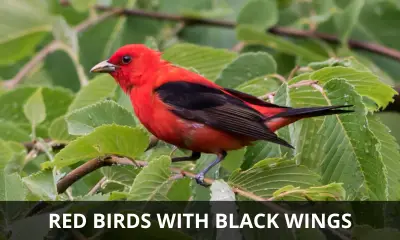
What are the types of red birds with black wings?
There are 11 types of red birds that have black wings, which are covered in full detail below.
Note that only the first 4 of these (Scarlet Tanager, Pine Grosbeak, Vermilion Flycatcher, and Rose-breasted Grosbeak) live in North America, while the others hail from other parts of the world.
Scarlet Tanager
Scientific name: Piranga olivacea
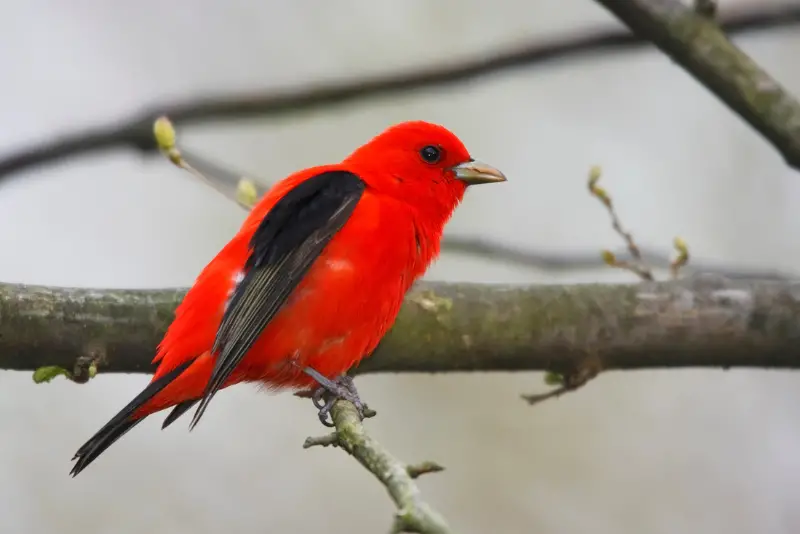
The Scarlet Tanager is a bird with a tropical appearance, due to the bright scarlet plumage of the males, which contrasts with their coal black wings and tail feathers.
But unlike the almost entirely red body of the male, the female has a more drab appearance, and looks like a little yellow bird.
This red bird is a summer visitor to North America, and spends its winter in Central and South America.
Both sexes sing a similar song in order to mark and defend their territory from other tanagers.
These black and red tanagers are insectivores, and feed on spiders and flying insects (including bees and wasps) high up in tree canopies.
Pine Grosbeak
Scientific name: Pinicola enucleator

The Pine Grosbeak is a small red songbird with black wings and a short and stubby bill.
Adult males are raspberry red with varying amounts of gray on their sides and bellies. The tail and the wings are black with two white wing bars.
Females are less colorful, and have a yellowish brown head and rump, with the rest of the body largely gray, except for the wings and tail, which are black and white.
Outside of the breeding season, the Pine Grosbeak often forages in flocks, and during cold winters it is sometimes forced to move south.
These black birds with a red chest breed in the mountainous regions of North America, where they are year-round residents.
Vermilion Flycatcher
Scientific name: Pyrocephalus obscurus
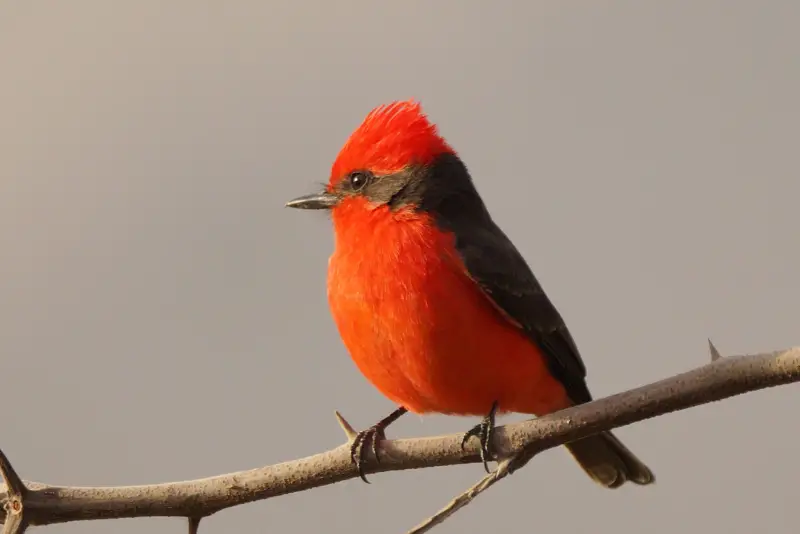
The Vermilion Flycatcher is one of the most beautiful songbirds of North America. Adult males are red-colored birds with black wings and a black mask, as well as a black tail.
Females and immatures, on the other hand, are grayish brown on top, and pale underparts.
This is a strict migratory bird, with most Vermilion Flycatchers migrating to Central America to spend the winter, with only a handful of individuals remaining in North America (mostly in Florida) during the cold season.
The preferred habitat of the Vermilion Flycatcher is open woodland and parks in areas close to water.
Rose-breasted Grosbeak
Scientific name: Pheucticus ludovicianus
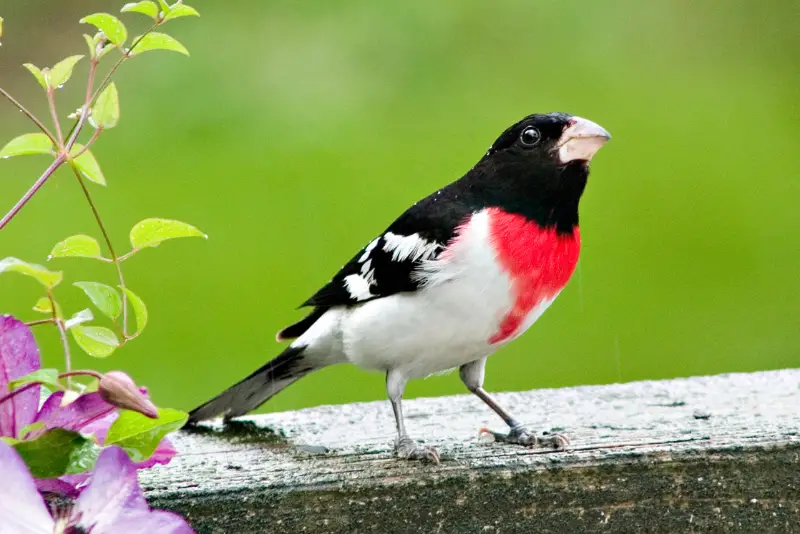
The Rose-breasted Grosbeak is a small red songbird with black and white wings, and is easily identifiable by its large beak.
During the summer, adult males have a scarlet chest, which contrasts with their jet black hood and back. Their black-colored wings have white patches and white wing bars.
Adult females and immature birds, on the other hand, have streaked brown plumage that is lighter on the underside than on the back. They also have a white eyebrow stripe and white wingbar.
Rose-breasted Grosbeaks are summer visitors in northern North America from May through August.
This small songbird is migratory, and flies to Central America to spend the winter months. Similar to other crossbill species, it specializes in feeding on the seeds of conifer cones.
Masked Crimson Tanager
Scientific name: Ramphocelus nigrogularis
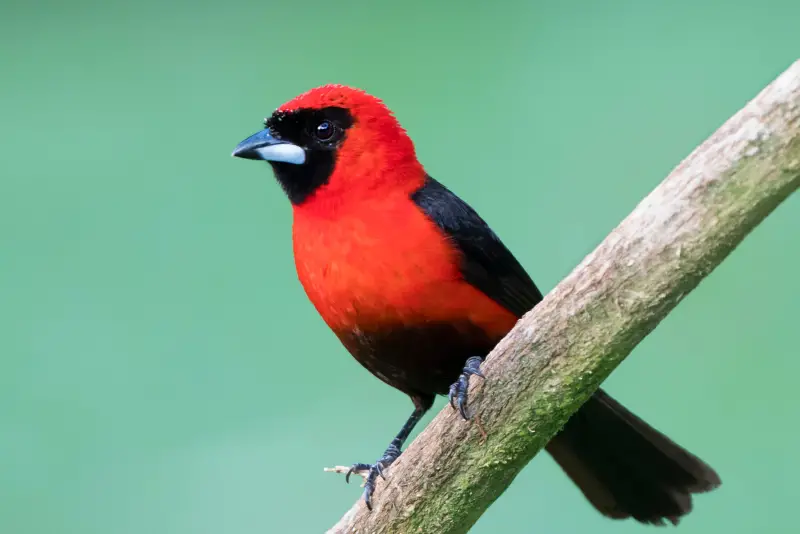
The Masked Crimson Tanager is a stunningly beautiful tropical bird found in the rainforests of northern South America.
And while this is not a North America bird, it sometimes shows up in the southern United States as a rare vagrant.
It’s easy to identify this bird, due to its crimson red and black plumage. Females look similar to males, but are slightly more drab.
Another great distinguishing feature is its silver colored lower bill, which contrasts with the black mask.
Andean Cock-Of-The-Rock
Scientific name: Rupicola peruvianus
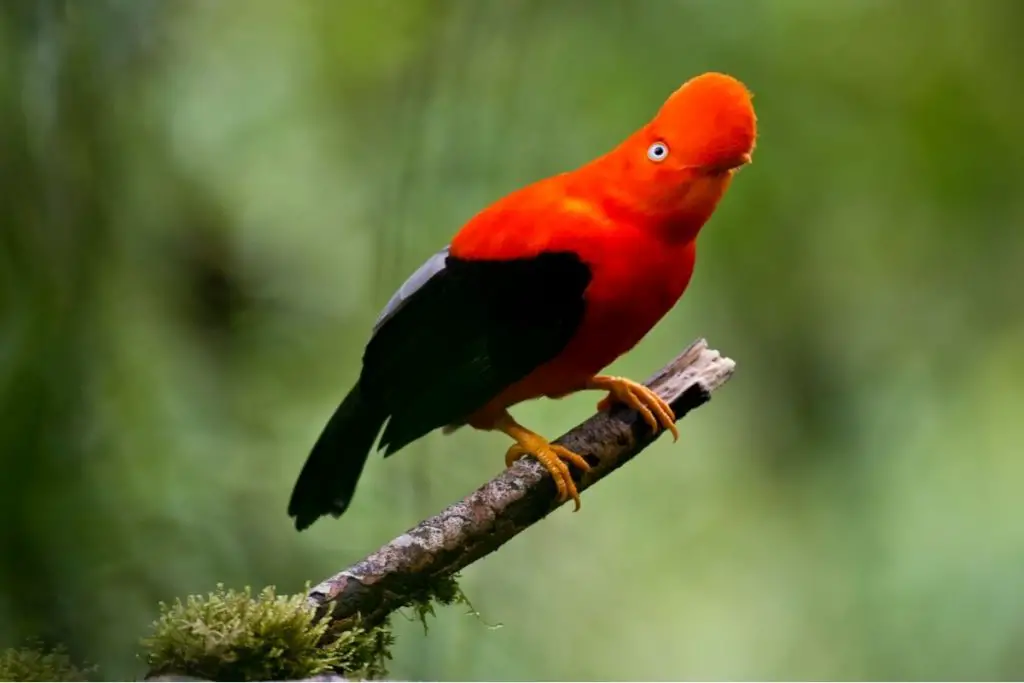
In all honesty, this bird looks pretty weird in general, not just because of its hair. With a quite bizarre appearance, this incredibly vibrant bird is half orange and half black.
Unsurprisingly found in the Andean cloud forests, this quite stylish bird uses its bright orange, fluffy hairdo to impress females during the mating season.
The male dances in front of the female, shaking its orange bobble of hair in an attempt to impress.
Also the national bird of Peru, the male Andean Cock-of-The-Rock bird makes a swift exit when the chicks are finally born.
Crimson Sunbird
Scientific name: Aethopyga siparaja

This is a relatively common sunbird in Southeast Asia, with a range that spans from Nepal to southern Indonesia.
Males have a bright red chest, head and upper back, while their wings are dark blackish gray. Males also have a thin dark strip extending from the lower beak, which looks like a moustache.
Females are more drab, and are buff yellow. And while these birds aren’t shy and are often found in urban environments, they are easily overlooked since they like to forage high up in the tree tops.
Crimson-backed Tanager
Scientific name: Ramphocelus dimidiatus
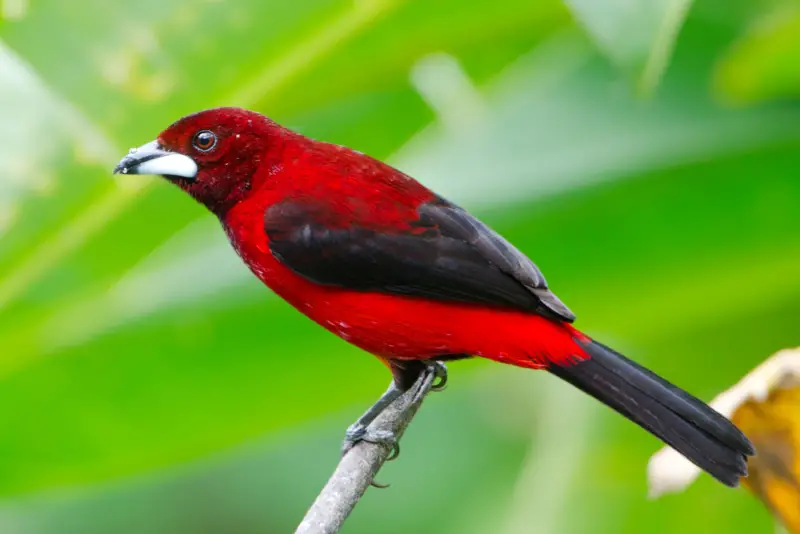
This is a dark velvety red tanager with black wings that has a relatively small range in northern South America (most notably in Colombia, Venezuela, and Nicaragua).
The bill has a silver hue, which is stronger in the lower mandible, which is also larger than the upper mandible.
Females look similar to males, but are not quite as brightly colored. Occurs in open forests and scrub land, where it is often encountered foraging in small flocks.
Brazilian Tanager
Scientific name: Ramphocelus bresilius
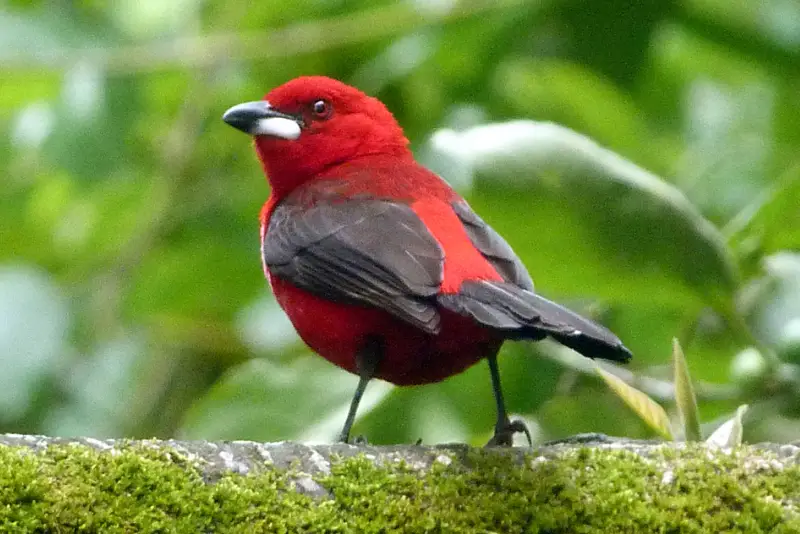
This large tanager has a mostly red body, contrasting with wings that are jet black, as well as a black tail. Just like the previous species it has a silver colored lower mandible of its beak.
Females are not as brightly colored, and look dark brown with a slightly lighter underside.
This bird is found along the coastal areas of Brazil, where it can be seen in open forests and in urban areas, including backyard gardens.
White-capped Redstart
Scientific name: Phoenicurus leucocephalus

This colorful redstart is found in Central and Southeast Asia, where its preferred habitat are mountain streams.
Both sexes are similar and have a wine red to rufous red belly and rump, as well as black wings, chest, head, and upper back.
A great distinguishing feature of these birds is their bright white crown.
Black-winged Lory
Scientific name: Eos cyanogenia
This large lory has a very small range restricted to northern Papua New Guinea, where it mostly occurs on the Bay Islands.
The Black-winged Lory has a red body with black wings, tail and a dark violet mask, but when spotted in flight, it looks almost entirely red from below.
These birds forage in small flocks or as pairs in mature forests, where they feed on flowering trees.
Final remarks
In summary, here are the 11 types of red birds that have black wings:
- Scarlet Tanager
- Vermilion Flycatcher
- Pine Grosbeak
- Rose-breasted Grosbeak
- Masked Crimson Tanager
- Crimson-backed Tanager
- Brazilian Tanager
- Crimson Sunbird
- Andean Cock-of-the-Rock
- White-capped Redstart
- Black-winged Lory
If you’ve spotted one of these birds with red plumage, but aren’t sure which species it was, check our detailed ID guide with photos above.
If you enjoyed this article, check out our guide to the red birds of Texas.
